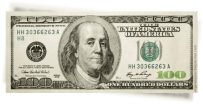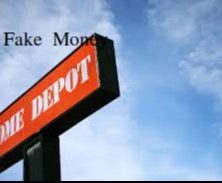Counterfeit Money Home Depot: How Do Fraudsters Do It?
Coins, checks, bank notes, and cards can all be forged and used for financial or personal gain. When it comes to counterfeiting money, the US dollar is the most common example because of its international acceptance and high value.
The use of counterfeit money is rampant in the US. In fact, the Chicago CBP discovered more than $1.6 million in just three months in 2021. Additionally, the Department of Treasury reported that $70 to $200 million of counterfeit money is in circulation.
In today’s modern era, people have many ways to own fake money and use it to pay for various goods and services. One of the most recent and talked about news items in this field is the counterfeit money Home Depot scam. In this article, you will find out who the culprit is, where he got the fake money and how he committed the crime.
But before all that, remember that making and using fake money is against the law, and this article will also state the corresponding penalties. The sole purpose of describing the methods used is for education.
All About Counterfeit Money
Counterfeit money is paper currency or coins that are made illegally. Counterfeiting is a kind of forgery where the manufacturer will produce money that is similar to the original currency. It’s also one of the oldest but most used techniques by fraudsters to fool people who are unaware of their intentions.
An ordinary person can obtain counterfeit money in two easy ways. They purchase fake money, play money, or money created for props in movies. They can do this using TikTok and other places, such as physical stores or online sites like Amazon. Fraudsters can also use the closest printable currency template they can find online and print it at home.
If you’re looking for how forgers counterfeit money, here are the steps. Let’s use $20 in this example.
- Choose the right paper. Cashiers or bank tellers know the “feel of money.” The paper must be thin and made of cotton and linen fibers, also known as rag paper.
- Set your scanner to its highest resolution (2,500 or 4,000 dpi) and scan the front and back of the US dollar bill.
- Align the front and back sides and use a high-quality printer for more authentic-looking money.
- In most cases, you will need to test the printout to ensure it has the right color and details.
- Different security features are impossible to fake with a regular inkjet printer, such as:
- The plastic security strip with the words “USA TWENTY” and the small flag in the thread that runs vertically on the paper are visible on both sides.
- The watermark only appears when you hold the bill up to the light.
- The color-shifting number “20” is on the bottom right corner of the bill.
Counterfeit Money Home Depot Crimes
Home Depot is a large store with many branches worldwide where you can buy all the supplies needed for building, maintaining, and renovating your home. Because of the wide selection of high-quality products, fraudsters or shoplifters often target the brand. But with the smooth and steady cooperation of the company, many individuals have been caught stealing and using counterfeit money at Home Depot.
Currently, two types of counterfeit money Home Depot crimes have been recorded and reported in the news. Learn about them and how they happened.
Acting Like a Buyer
Shopping with counterfeit money is common at Home Depot, and in our investigation, there were four counterfeit money Home Depot crimes recorded since 2019. These incidents happened at Home Depot branches in Auburn, Boardman, and Boise. Still, according to reports, the individuals arrested admitted that they attempted to use fake money (and had done so successfully in some instances) in other branches before the police caught them.
Criminals in this type of fraud can work individually or as a group, like in Auburn. The group attempted to purchase items with fake money worth $1,000 and use different check-out lines simultaneously. The management of Home Depot was alerted instantly and approved one of the three transactions to delay the others while waiting for the police.
Doing it alone is more dangerous, but this did not deter some of these individuals. This is because they often successfully paid using counterfeit money at Home Depot and held at least $10,000 of it in their pockets or in their cars. This technique was almost the same, they purchased various items such as power tools, but the total payment per transaction was between $100 and $500 so that the cashiers did not become suspicious.
Inside Job
In February 2022, news about a $387,500 counterfeit money Home Depot financial crime appeared on television and online news sites. According to the US Secret Service, who handled and planned the entrapment, the culprit was poised to commit the crime. The culprit’s name was Adrian Jean Pineda; he worked as a vault associate at Home Depot and was responsible for sorting, counting, and closing cash bags to be deposited at Wells Fargo Bank.
Because of the CCTV footage, the Home Depot in Tempe, Arizona, caught Pineda taking real money and replacing it with counterfeit money during his shifts between January 2018 and January 2022. With the help of Pheonix special agents, security personnel of Home Depot, and the bank during the investigation, they were able to arrest the perpetrator and discover $5,000 in counterfeit money and recover a total of $27,300 in genuine currency.
Pineda admitted to his crime and said he bought $100 bill movie props from Amazon at $8.96 for a pack of 100. The bills are perfectly printed with the adjacent vertical blue line and are highly realistic, but instead of a serial number, the word “play money” is printed. Here’s how Pineda successfully bypassed the first counterfeit detection and executed the counterfeit money Home Depot crime for almost four years.
- He went to work with between $800 and $1,200 in fake money every day.
- After the cashier brought him the money and receipts, he immediately counted the money like a regular employee.
- When he was about to finish counting, he would take a fake $100 bill from his wallet and add it to the cash in his hands.
- Next, he put the stack of $100 bills on a money counter set to a specific number of paper bills.
- After the money counter finished counting, he bundled it and included it in the money bags that were deposited into the Home Depot’s bank.
- Then, he immediately crumpled all the money left in the machine and put it in his pocket.
Laws and Punishment in Counterfeiting Money
The federal government and the Secret Service work together and take counterfeiting cases seriously to catch counterfeiters and seize millions of dollars in fake money. Below are the federal and state laws and penalties for committing counterfeit money Home Depot financial crime in the US.
Federal Laws
In Pineda’s case, he faces a charge of violating 18 USC 472 or Uttering of Counterfeit US Currency which means imprisonment of between 15 and 20 years. He might also pay a $15,000 fine in addition to the $400,000 he agreed to pay back to Home Depot. The 18 USC 471 is for illegal manufacturers, which is punishable by a fine of $5,000, 15 years in prison, or both.
There are more federal laws related to counterfeit currency, but in these two statutes, it is a crime to:
- Hold, keep, publish, make, or sell counterfeit currency with fraudulent intent.
- Buy, receive, or send counterfeit money with the express intention that it will be used or exchanged for real cash.
- Keep or sell imprints, digital images, or other counterfeiting equipment to commit fraud.
States Laws
There are also states in the US that have their own counterfeiting laws to follow. Anyone suspected of using counterfeit money will be committing one or more financial crimes, including forgery and fraud. For example, in Maryland, a person who holds and illegally issues counterfeit money can be sentenced to 3 years imprisonment and pay a fine of $1,000 as it is a violation of Md. Code, Crim. Law 8-604.1.
Another state law is Minnesota’s Minn.Stat 609.632, where the penalties for passing or selling counterfeit money depend on the face value of the currency. If convicted, the maximum sentence is 20 years on the felony charge. However, anyone using counterfeit money in Georgia will be charged with forgery and will face imprisonment of up to 15 years.
Can a Person Who Does Not Know That Their Money Is Fake Go to Jail?
It’s highly illegal to have counterfeit money, and even if you don’t mean to use it to make transactions, like at Home Depot, it will create a problem. You could be prosecuted, depending on your situation. To defend yourself against unknowingly using fake money, here are your legal defenses:
- You didn’t know its fake,
- You have no intention of using counterfeit money or deceiving people. And
- The management falsely accused you
Identifying Counterfeited Money
You will not want to be in such a situation, so it’s better to ensure that your money is genuine before you use it. You can use the checklist issued by the US Secret Service to know your money. Here are the signs that your paper bill is fake.
- The portrait in real dollar bills is lifelike and two-dimensional, while the picture in fake paper bills is dull, flat, darker, and the details are unclear.
- In real money, the federal reserve and treasury seals are bright, uniform, and sharp, but with counterfeit bills, the seals are uneven, dull, and damaged.
- The borderlines must be clear and solid. Unlike in a counterfeit currency, the borders are blurred and not connected.
- Both genuine and fake money has red and blue fibers, but with real money, it’s threaded into the paper. On the other hand, in counterfeit bills, the red and blue lines are all made with ink.
- The serial numbers in real money are spaced evenly, the same color as the treasury seal, and printed in a unique font. Meanwhile, the serial numbers in counterfeit bills are in a lighter or darker shade, not evenly spaced and properly aligned.
Final Thoughts
Because of the sheer number of people who can use counterfeit money at Home Depot, it’s probably one of the simplest financial crimes out there today. It’s an easy crime, but anyone caught will be imprisoned for at least 15 years if arrested and found guilty. In this article, we covered the different types of counterfeit money crime at Home Depot, including the laws and the corresponding penalties to make everyone more aware of this bad practice.
If you are falsely accused of using counterfeit money, always seek the help of an attorney. You can also use our tips to ensure your money is genuine and safe to use. For those who have a business, it is vital to keep an eye on your employees, strengthen security, and use fake money detectors.


Recent Comments